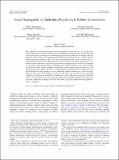| dc.contributor.author | Masutomi, Keiko | |
| dc.contributor.author | Barascud, Nicolas | |
| dc.contributor.author | Kashino, Makio | |
| dc.contributor.author | Chait, Maria | |
| dc.contributor.author | McDermott, Josh | |
| dc.date.accessioned | 2016-05-13T16:31:57Z | |
| dc.date.available | 2016-05-13T16:31:57Z | |
| dc.date.issued | 2015-10 | |
| dc.date.submitted | 2015-08 | |
| dc.identifier.issn | 1939-1277 | |
| dc.identifier.issn | 0096-1523 | |
| dc.identifier.uri | http://hdl.handle.net/1721.1/102477 | |
| dc.description.abstract | The segregation of sound sources from the mixture of sounds that enters the ear is a core capacity of human hearing, but the extent to which this process is dependent on attention remains unclear. This study investigated the effect of attention on the ability to segregate sounds via repetition. We utilized a dual task design in which stimuli to be segregated were presented along with stimuli for a “decoy” task that required continuous monitoring. The task to assess segregation presented a target sound 10 times in a row, each time concurrent with a different distractor sound. McDermott, Wrobleski, and Oxenham (2011) demonstrated that repetition causes the target sound to be segregated from the distractors. Segregation was queried by asking listeners whether a subsequent probe sound was identical to the target. A control task presented similar stimuli but probed discrimination without engaging segregation processes. We present results from 3 different decoy tasks: a visual multiple object tracking task, a rapid serial visual presentation (RSVP) digit encoding task, and a demanding auditory monitoring task. Load was manipulated by using high- and low-demand versions of each decoy task. The data provide converging evidence of a small effect of attention that is nonspecific, in that it affected the segregation and control tasks to a similar extent. In all cases, segregation performance remained high despite the presence of a concurrent, objectively demanding decoy task. The results suggest that repetition-based segregation is robust to inattention. | en_US |
| dc.description.sponsorship | James S. McDonnell Foundation (Scholar Award) | en_US |
| dc.language.iso | en_US | |
| dc.publisher | American Psychological Association (APA) | en_US |
| dc.relation.isversionof | http://dx.doi.org/10.1037/xhp0000147 | en_US |
| dc.rights | Creative Commons Attribution | en_US |
| dc.rights.uri | http://creativecommons.org/licenses/by/3.0/ | en_US |
| dc.source | Journal of Experimental Psychology | en_US |
| dc.title | Sound segregation via embedded repetition is robust to inattention | en_US |
| dc.type | Article | en_US |
| dc.identifier.citation | Masutomi, Keiko, Nicolas Barascud, Makio Kashino, Josh H. McDermott, and Maria Chait. “Sound Segregation via Embedded Repetition Is Robust to Inattention.” Journal of Experimental Psychology: Human Perception and Performance 42, no. 3 (2016): 386–400. | en_US |
| dc.contributor.department | Massachusetts Institute of Technology. Department of Brain and Cognitive Sciences | en_US |
| dc.contributor.mitauthor | McDermott, Josh | en_US |
| dc.relation.journal | Journal of Experimental Psychology: Human Perception and Performance | en_US |
| dc.eprint.version | Final published version | en_US |
| dc.type.uri | http://purl.org/eprint/type/JournalArticle | en_US |
| eprint.status | http://purl.org/eprint/status/PeerReviewed | en_US |
| dspace.orderedauthors | Masutomi, Keiko; Barascud, Nicolas; Kashino, Makio; McDermott, Josh H.; Chait, Maria | en_US |
| dspace.embargo.terms | N | en_US |
| dc.identifier.orcid | https://orcid.org/0000-0002-3965-2503 | |
| mit.license | PUBLISHER_CC | en_US |
